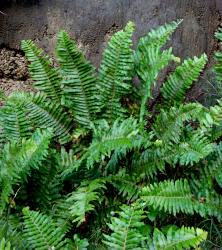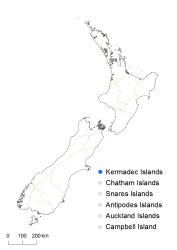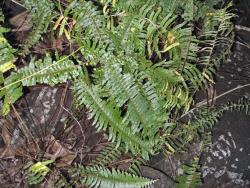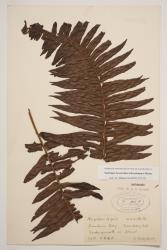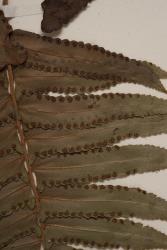- ≡ Nephrodium brownii Desv., Mém. Soc. Linn. Paris 6: 252 (1827)
Terrestrial ferns. Rhizomes erect, abundantly scaly, producing long-creeping runners with adventitious buds, lacking tubers. Rhizome scales appressed, narrowly ovate, 2.5–3 mm long, 0.6–0.7 mm wide, peltate, with narrow pale margins and dark centres, shining, ciliate on margins. Fronds usually 300–1830 mm long, or rarely stunted fronds c. 100 mm long found around fumaroles. Stipes 70–610 mm long, or rarely 20 mm long on stunted fronds, pale brown, brittle; bearing scales proximally similar to those of rhizomes, becoming similar to those of the rachises distally. Rachises pale brown, densely scaly; rachis scales spreading, narrowly ovate, hyaline or light brown, long-ciliate on margins. Laminae 1-pinnate, elliptic to narrowly elliptic, tapering to apex; fertile laminae 240–1220 mm long, or rarely only 100 mm long in stunted fronds, 30–285 mm wide (sterile laminae often wider), yellow-green on both surfaces, herbaceous; hair-like scales on costae and both lamina surfaces, multicellular hairs up to 0.2 mm long on costae only. Primary pinnae in 18–75 pairs, not overlapping; the longest near the middle, 34–155 mm long, or rarely only 20 mm long in stunted fronds, 7–17 mm wide, narrowly ovate with a small basal acroscopic lobe, slightly falcate; basal pinnae much reduced; pinna apices acute to acuminate, margins irregularly serrate or lobed, bases short-stalked. Sori round, terminating veins just inside the pinna margins; indusia reniform with narrow sinus, attached at sinus, 1–1.5 mm long. Mean spore size 34.5–37.5 μm long, 22.5–24.5 μm wide; perispores pale brown, verrucate.
Nephrolepis brownii is distinguished from N. cordifolia and N. flexuosa by its longer pinnae (34–155 mm long, cf. 9–53 mm long), which are abundantly covered in scales on both surfaces and bear multicellular hairs on the costae. The sori are longer than in the other species (1–1.5 cf. 0.5–1 mm), and the indusia are reniform with narrow sinuses. It is distinguished from N. exaltata by its shining appressed rhizome scales; by its sterile pinnae, which are auricled acroscopically; and by the pinna margins, which are irregularly serrate or lobed rather than minutely serrate. The species occurs in New Zealand only on the Kermadec Islands and does not naturally reach the North Island, though it is occasionally cultivated there. On the Kermadec Islands occasional stunted plants are found around fumaroles, and these have fronds with much smaller dimensions.
Kermadec Islands
Altitudinal range: 5–170 m.
In the New Zealand region Nephrolepis brownii occurs only on the Kermadec Islands, where it has been recorded from Raoul, Dayrell, Macauley and Curtis Islands (Sykes 1977; de Lange 2015). On Raoul Island it is locally common in coastal and lower slopes, perhaps up to 300 m. It has been recorded in permanent plots on Raoul Island from 10 to 70 m (C.J. West, pers. comm.), from one collection at 150 m near Sentinel Point, and from observations in Sunshine Valley and the ridge to Prospect (P.J. de Lange, pers. comm.). On Curtis Island it reaches 120 m, and on Macauley Island up to 170 m.
Also India, Sri Lanka, southern China, Taiwan, south-east Asia, Papua New Guinea, Australia (Western Australia, Northern Territory, Queensland), Solomon Islands, New Caledonia, Fiji, Tonga, Cook Islands, Rapa, Society Islands and Pitcairn Island. It is naturalised in tropical America and Hawai‘i (Hovenkamp & Miyamoto 2005).
Nephrolepis brownii occurs in open ground, mostly in coastal and low-altitude forest, in shrubland, in clearings and around old cultivation sites, on banks and road margins, among boulders, and around thermal vents, forming "large, dense, almost pure stands" (Sykes 1977). On rich soil in the Denham Bay area it is said to reach 2 m in height (Sykes 1977), but in fernland near the coast it is more stunted.
Nephrolepis brownii was given a conservation status of At Risk / Naturally Uncommon by de Lange et al. (2018).
2n = 82 (de Lange et al. 2004 – as N. hirsutula)
This species was widely misidentified as Nephrolepis exaltata (L.) Schott by earlier New Zealand authors, including Allan (1961), and as N. hirsutula (G.Forst.) C.Presl by authors since Sykes (1977). It is very similar to N. hirsutula and the two species occur together in much of south-east Asia and the tropical Pacific (Hovenkamp & Miyamoto 2005).



